|
|
|
Sort Order |
|
|
|
Items / Page
|
|
|
|
|
|
|
| Srl | Item |
| 1 |
ID:
137178
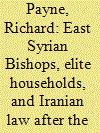

|
|
|
|
|
| Summary/Abstract |
This article is an exploration of the interconnected legal ties between Christians and Zoroastrians in the early Islamic era. Drawing from the writings of the Christian authors Ishobokt, Simeon, and Henanisho, Payne describes how East Syrian bishops appropriated laws of marriage, inheritance, and property from Iranian jurisprudential traditions as a means of transferring wealth intergenerationally and extending their judicial authority. Payne thus explores the ways in which the Christians of Iran were influenced by the Iranian legal system and culture and in the seventh century CE.
|
|
|
|
|
|
|
|
|
|
|
|
|
|
|
|
| 2 |
ID:
091287
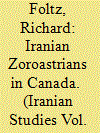

|
|
|
|
|
| Publication |
2009.
|
| Summary/Abstract |
Canada, now the number-one destination for Iranian migrants, is home to one of the world's most dynamic Zoroastrian communities, in which Iranians are increasingly represented and are playing ever more visible roles in maintaining and transforming the tradition. While exile has in some ways reunited Iranian and Parsi (South Asian) Zoroastrians after more than 1,000 years of separation, cultural and in some cases religious differences mean that they continue largely to live in separate spheres even while sharing their places of worship. Iranian Zoroastrians in Canada participate in some social settings as Iranians, in others as Zoroastrians, and in still others as Canadians, but to a large extent they remain a community unto themselves separate from these other three. Even so, their generally progressive interpretations of Zoroastrianism are having an influence on Parsi communities worldwide as well as on Zoroastrians in Iran, and being often recognized as "original Iranians" they are playing important roles in promoting awareness of Iranian culture within the broader community.
|
|
|
|
|
|
|
|
|
|
|
|
|
|
|
|
| 3 |
ID:
119603
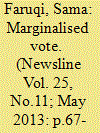

|
|
|
| 4 |
ID:
188841
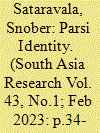

|
|
|
|
|
| Summary/Abstract |
This article discusses the politics of identity and narratives of the Parsi minority community in India, who are Indian Zoroastrians on the brink of extinction. The mapping of the mythical construction of the Parsis by the Parsis themselves is contrasted with representations by popular culture. The main concern is that when there are no more Parsis left in South Asia to participate in this dialogue regarding the manufacture of identity, unchallenged stereotypes will persist, to the disadvantage of the community. Specifically, the character of the mad Parsi (yeda) in Hindi cinema will remain predominant in popular imagination, while narratives of great Parsi entrepreneurs will be absorbed into general narratives of the nation, and collective memory will privilege the queer, the fool, the drug dealer or the anti-Christ.
|
|
|
|
|
|
|
|
|
|
|
|
|
|
|
|
| 5 |
ID:
186915
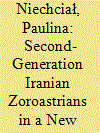

|
|
|
|
|
| Summary/Abstract |
The article contributes to filling the research gap concerning Iranian Zoroastrians in diaspora. Using a narrative approach, it explores how second-generation Zoroastrians raised in the United States learn and practice religion while facing the challenges of a pluralistic American society. The article includes a case study of two young Zoroastrian women interviewed in 2019, members of the Californian community. The contrastive cases shed light on the internal heterogeneity of Zoroastrianism, different ways the religion is perceived and experienced, and different ideas about future preservation of the ethno-religious heritage. The study contributes to an understanding of how Zoroastrianism evolves on a new continent and how it differs from what Zoroastrian immigrants brought from Iran.
|
|
|
|
|
|
|
|
|
|
|
|
|
|
|
|
| 6 |
ID:
189070
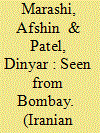

|
|
|
|
|
| Summary/Abstract |
This photo essay provides a visual archive of Parsi philanthropic efforts toward the Iranian Zoroastrian communities of Yazd, Kerman, and Tehran during the 1930s. The essay reproduces a collection of photographs from a photo album produced by the Iranian Zoroastrian Anjoman (est. 1918) for the benefit of Parsi audiences in Bombay. These photographs were taken and compiled by administrators of the Parsi-funded charities in order to demonstrate to Bombay-based Parsi benefactors how their charity efforts were being used inside Iran. The essay also discusses the importance of including visual archival material as part of the social and cultural history of modern Iran, as well as the unique sets of challenges that such archival preservation represents.
|
|
|
|
|
|
|
|
|
|
|
|
|
|
|
|
| 7 |
ID:
102015
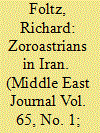

|
|
|
|
|
| Publication |
2011.
|
| Summary/Abstract |
Zoroastrianism, a religion which arose among Iranian peoples some 3,000 years ago, was the religion of the majority of Iranians prior to the Arab conquests of the mid-7th century. Since that time, a steady process of conversion to Islam has left a small Zoroastrian minority of 20,000 or less in Iran today. While community leaders are making efforts to keep the religion alive, factors such as emigration, intermarriage, and low birth rates now put the very survival of this ancient faith into question, not just throughout the global diaspora but within the land of its birth.
|
|
|
|
|
|
|
|
|
|
|
|
|
|
|
|
|
|
|
|
|